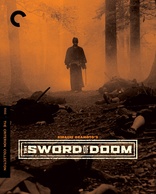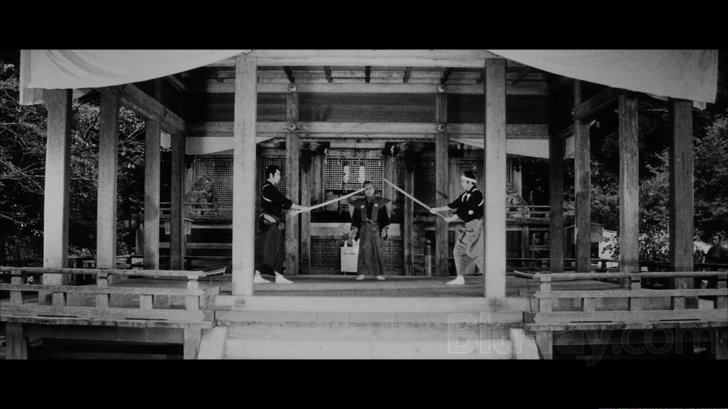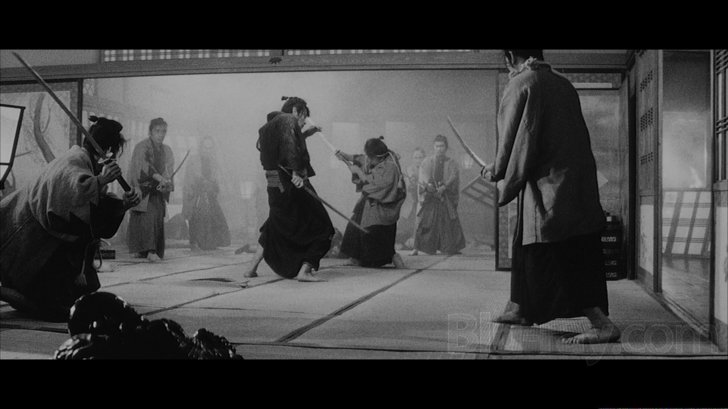The Sword of Doom Blu-ray Movie
HomeThe Sword of Doom Blu-ray Movie 
大菩薩峠 / Dai-bosatsu t˘geCriterion | 1966 | 120 min | Not rated | Jan 06, 2015

Movie rating
7.8 | / 10 |
Blu-ray rating
| Users | 0.0 | |
| Reviewer | 3.5 | |
| Overall | 3.5 |
Overview
The Sword of Doom (1966)
Through his unconscionable actions against others, a sociopath samurai builds a trail of vendettas that follow him closely.
Starring: Tatsuya Nakadai, Toshir˘ Mifune, Michiyo Aratama, Tadao Nakamaru, Kei Sat˘Director: Kihachi Okamoto
| Foreign | 100% |
| Drama | 61% |
| Period | 6% |
| Action | Insignificant |
Specifications
Video
Video codec: MPEG-4 AVC
Video resolution: 1080p
Aspect ratio: 2.35:1
Original aspect ratio: 2.35:1
Audio
Japanese: LPCM Mono (48kHz, 24-bit)
Subtitles
English
Discs
50GB Blu-ray Disc
Single disc (1 BD)
Playback
Region A (locked)
Review
Rating summary
| Movie | 4.5 | |
| Video | 3.5 | |
| Audio | 4.5 | |
| Extras | 2.5 | |
| Overall | 3.5 |
The Sword of Doom Blu-ray Movie Review
Reviewed by Dr. Svet Atanasov December 29, 2014Kihachi Okamoto's "The Sword of Doom" (1966) arrives on Blu-ray courtesy of Criterion. The supplemental features on the disc include an original Japanese trailer for the film and new and exclusive audio commentary with film scholar Stephen Prince. The release also arrives with an illustrated leaflet featuring an essay by critic Geoffrey O'Brien. In Japanese, with optional English subtitles for the main feature. Region-A "locked".

Duel
The young and fearless samurai Ryunosuke (Tatsuya Nakadai, Kagemusha) kills an elderly pilgrim supposedly to let his beautiful granddaughter, Omatsu (Y˘ko Naito, Red Beard), who has been following him for years, choose a new direction in her life. Later on, Ryunosuke meets Hama (Michiyo Aratama, Kwaidan), the wife of another swordsaman who has been scheduled to meet him in a prestigious tournament at Mount Mitake, who begs him not to humiliate her husband (Ichiro Nakatani, Blueprint of Murder) because if he loses the duel he would also lose his position at the Kogen School. Ryunosuke agrees to do so -- but only if Hama surrenders her chastity. When Hamaĺs husband discovers that she has spent a night with Ryunosuke, he immediately divorces her. Then, filled with anger, he also attempts to hurt Ryunosuke, but instead gets his head split in half. Feeling partially responsible for Hamaĺs misery, Ryunosuke allows her to come live with him.
Unable to make ends meet, Ryunosuke joins a gang of outlaws whose ambitious leader, Serizawa (Kei Sato, Kuroneko), dreams of bringing down the shogunate. Soon after, he is asked to choose between the gangĺs two rivaling factions.
Meanwhile, Hamaĺs brother-in-law, Hyoma (Yuzo Kayama, 47 Samurai), vows to kill Ryunosuke and begs the great master Shimada (Toshiro Mifune) to teach him the tsuki thrust so that he can defeat the evil samurai.
Kihachi Okamotoĺs The Sword of Doom is the darkest and most nihilistic of the big samurai films. Unlike the just, forgiving and genuinely likeable characters that typically populate Akira Kurosawa, Masaki Kobayashi, Hideo Gosha and Hiroshi Inagakiĺs classic films, Ryunosuke is a vile and brutal psychopath whose sword strikes the weak and innocent as often as it does his opponents. What is genuinely disturbing about this anti-hero, however, is the fact that the film not only does not attempt to ridicule him -- as, for instance, Kurosawa does Sanjuro -- but actually repeatedly admires his actions and at the end even grants him an honorable exit. Needless to say, viewing The Sword of Doom after the likes of Seven Samurai, Harakiri and Sword of the Beast very much feels like a painful slap on the face in the middle of a beautiful dream.
Nakadai is superb as the brutal samurai. There is something genuinely disturbing in the way he looks at Hama, for instance, before he rapes her, and later on, when the outlaws attack him his body movement is quite simply spectacular. Mifune, the iconic Japanese actor, has a limited time in front of the camera, but there is great sequence in which he is forced to defend himself while Nakadai observes him from afar.
The film is based on the popular novel by Kaizan Nakazato, which was adapted by the great writer Shinobu Hashimoto. (The latter also wrote the scripts for such classic films as Rash˘mon, Seven Samurai, Throne of Blood and Harakiri). The structure of the narrative is rather surprising as different parts of it are quite uneven, but as film scholar Stephen Prince notes in his commentary on this release Okamoto must have assumed that most viewers were already familiar with the original story and focused on Ryunosukeĺs unusual personality.
During the years, Nakazotoĺs novel, which is considered one of the longest ever written in any language, has been adapted multiple times. Other notable adaptations include the Dai-bosatsu Tōge films (Inagaki/1935), the Sword in the Moonlight trilogy (Tomu Uchida/1957), and the Satanĺs Sword films (Kenji Misumi and Kazuo Mori/1960).
The Sword of Doom Blu-ray Movie, Video Quality 

Presented in its original aspect ratio of 2.35:1, encoded with MPEG-4 AVC and granted a 1080p transfer, Kihachi Okamoto's The Sword of Doom arrives on Blu-ray courtesy of Criterion.
The following text appears inside the leaflet provided with this Blu-ray release:
"This high-definition digital transfer was created on a Cintel C-Reality film scanner with OLIVER electronic wet-gate processing from the 35mm composite fine-grain master. Thousands of instances of dirt, debris, scratches, splices, warps, and jitter were manually removed using MTI's DRS and Pixel Farm's PFClean, while Digital Vision's Phoenix was used for flicker.
Transfer supervisor: Maria Palazzola.
Colorist: Gregg Garvin/Modern VideoFilm, Los Angeles."
Generally speaking, detail and clarity are quite good and many of the darker sequences also boast much improved depth (on the old DVD release they tend to look rather flat and noisy). Some density fluctuations are present, but they can be traced back to the current master. Furthermore, in select sequences there are visible traces of light contrast and sharpness boosting. I assume that the most obvious sharpening adjustments also exist on the current master Criterion worked with as it is easy to see that efforts were made to rebalance the image as best as possible (compare screencaptures #11 and 15). As a result, though not distracting some areas of the film could look a bit harsher than they should. Grain is visible and for the most part rather well resolved, but because of the density fluctuations mentioned above at times it could be underexposed (see screencapture #9). Overall image stability is good, though occasionally some extremely light movement within the frame can be noticed. There are no large debris, cuts, stains, or damage marks to report in this review. All in all, even though it is very clear that there is room for some important improvements, the Blu-ray release does represents a good upgrade in quality over the existing DVD release of the film. (Note: This is a Region-A "locked" Blu-ray release. Therefore, you must have a native Region-A or Region-Free PS3 or SA in order to access its content).
The Sword of Doom Blu-ray Movie, Audio Quality 

There is only one standard audio track on this Blu-ray release: Japanese LPCM 1.0. For the record, Criterion have provided optional English SDH subtitles for the main feature. When turned on, they appear inside the image frame.
The lossless audio track is very good. While there are obvious production limitations and dynamic intensity is modest at best, clarity and depth are very good. Also, the dialog is crisp, clean, stable, and easy to follow. There are no balance issues. Lastly, there are no audio dropouts or digital distortions to report in this review. The English translation is excellent. (The technical descriptions of the different fighting techniques, in particular, are outstanding).
The Sword of Doom Blu-ray Movie, Special Features and Extras 

- Commentary - in this brand new audio commentary, cinema scholar Stephen Prince, author of Classical Film Violence, discusses Kihachi Okamoto's unique body of work (there are some excellent comments about his more casual films and the 'serious' samurai films), the Japanese director's obvious admiration for Yojimbo and some of the framing similarities between Akira Kurosawa's film and The Sword of Doom, the chronology of the events in the film, the key conflicts and Tatsuya Nakadai's terrific performance, etc. The commentary was recorded exclusively for Criterion in 2014.
- Trailer - original Japanese trailer for The Sword of Doom. In Japanese, with optional English subtitles. (3 min, 1080p).
- Leaflet - illustrated leaflet featuring an essay by critic Geoffrey O'Brien.
The Sword of Doom Blu-ray Movie, Overall Score and Recommendation 

It is rather disappointing that The Sword of Doom did not end up being the first installment in the trilogy Toho and Kihachi Okamoto were planning to produce in the early '60s. It would have been spectacular, as I feel that authentic samurai films should look exactly like The Sword of Doom -- very dark, gritty and nihilistic. The film could look better, but the Blu-ray release unquestionably represents a good upgrade in quality over Criterion's previous DVD release. If you enjoy samurai films, do not miss this one. RECOMMENDED.
Similar titles
Similar titles you might also like

Harakiri
切腹 / Seppuku
1962

Three Outlaw Samurai
三匹の侍 / Sanbiki no samurai
1964

Lady Snowblood
修羅雪姫 / Shurayukihime
1973

Sansho the Bailiff
山椒大夫 / Sansh˘ dayű
1954

The Tale of Zatoichi
座頭市物語 / Zat˘ichi monogatari
1962

Throne of Blood
蜘蛛巣城 / Kumonosu-j˘
1957

Samurai III: Duel at Ganryu Island
宮本武蔵完結編 決闘巌流島 / Miyamoto Musashi kanketsuhen: kett˘ Ganryűjima
1956

Zatoichi Challenged
座頭市血煙り街道 / Zat˘ichi chikemuri kaid˘
1967

Zatoichi Goes to the Fire Festival
座頭市あばれ火祭り / Zat˘ichi abare-himatsuri
1970

Zatoichi the Outlaw
座頭市牢破り / Zat˘ichi r˘yaburi
1967

Zatoichi at Large
座頭市御用旅 / Zat˘ichi goy˘-tabi
1972

Zatoichi in Desperation
新座頭市物語・折れた杖 / Shin Zat˘ichi monogatari: Oreta tsue
1972

Samurai II: Duel at Ichijoji Temple
続宮本武蔵 一乗寺の決闘 / Zoku Miyamoto Musashi: Ichij˘ji no kett˘
1955

Yojimbo
用心棒 / Y˘jinb˘
1961

Lady Snowblood 2: Love Song of Vengeance
修羅雪姫 怨み恋歌 / Shurayuki-hime: Urami koiuta
1974

Sanjuro
椿三十郎 / Tsubaki Sanjűr˘
1962

The Life of Oharu
西鶴一代女 / Saikaku ichidai onna
1952

Fight, Zatoichi, Fight
座頭市血笑旅 / Zat˘ichi kessh˘-tabi
1964

Zatoichi and the Chess Expert
座頭市地獄旅 / Zat˘ichi Jigoku tabi
1965

Zatoichi and the Chest of Gold
座頭市千両首 / Zat˘ichi senry˘-kubi
1964